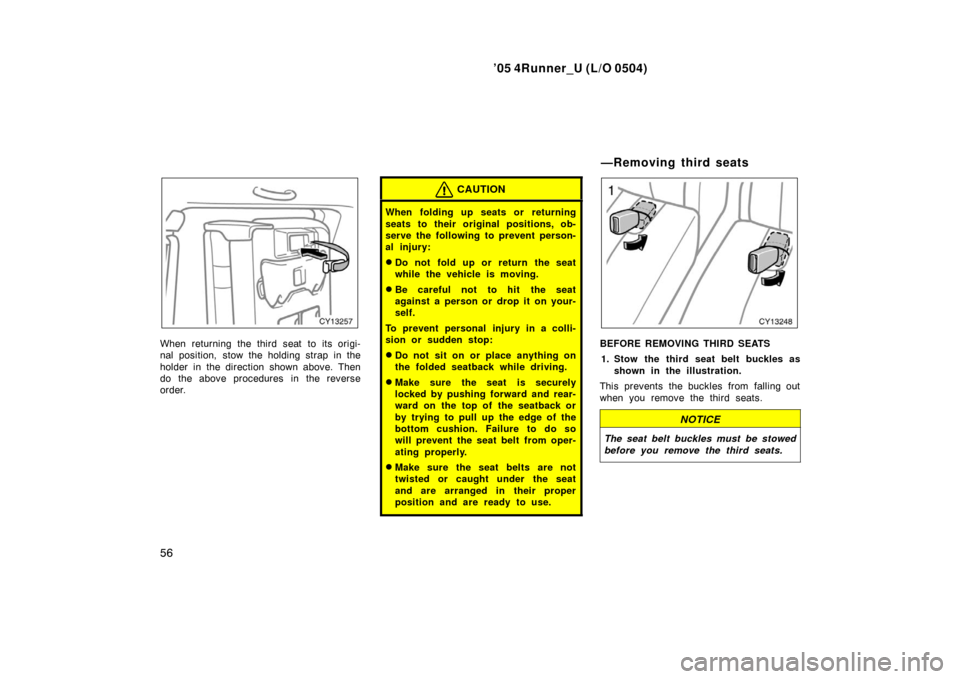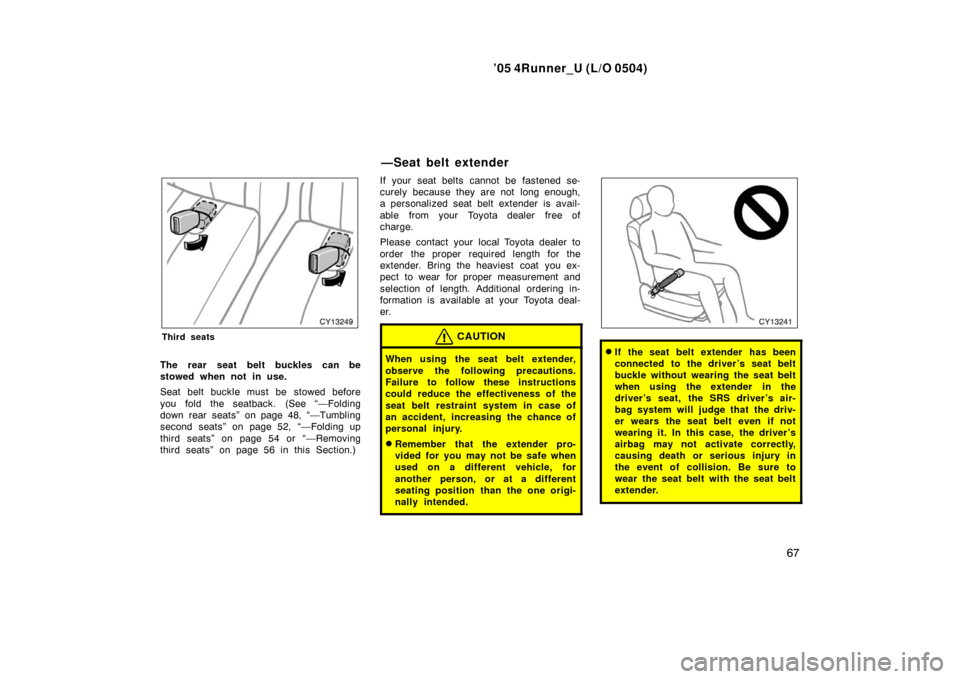Page 66 of 426

’05 4Runner_U (L/O 0504)
56
When returning the third seat to its origi-
nal position, stow the holding strap in the
holder in the direction shown above. Then
do the above procedures in the reverse
order.
CAUTION
When folding up seats or returning
seats to their original positions, ob-
serve the following to prevent person-
al injury:
�Do not fold up or return the seat
while the vehicle is moving.
�Be careful not to hit the seat
against a person or drop it on your-
self.
To prevent personal injury in a colli-
sion or sudden stop:
�Do not sit on or place anything on
the folded seatback while driving.
�Make sure the seat is securely
locked by pushing forward and rear-
ward on the top of the seatback or
by trying to pull up the edge of the
bottom cushion. Failure to do so
will prevent the seat belt from oper-
ating properly.
�Make sure the seat belts are not
twisted or caught under the seat
and are arranged in their proper
position and are ready to use.
BEFORE REMOVING THIRD SEATS 1. Stow the third seat belt buckles as shown in the illustration.
This prevents the buckles from falling out
when you remove the third seats.
NOTICE
The seat belt buckles must be stowed
before you remove the third seats.
—Removing third seats
Page 68 of 426
’05 4Runner_U (L/O 0504)
58
3. Remove the cover and push the seat
lock release lever outward to unlock
the seat lock, then pull up the whole
seat and remove it. After removing
the seat, reinstall the cover.
Removing the third seats will enlarge the
luggage compartment. See “—Stowage
precautions” on page 305 in Section 2 for
precautions when loading luggage.
NOTICE
Avoid putting heavy loads on the re-
moved seat. The metallic tips of the
seat leg may be damaged and the
seat cannot be reinstalled.
4. Remove the seat anchor covers from the back of the seat cushion, and
install them over the seat anchors.
CAUTION
Be sure to apply the covers on the
seat anchors, or you may get burned
when they become hot.
Page 76 of 426
’05 4Runner_U (L/O 0504)
66
CAUTION
Always make sure the shoulder belt
is positioned across the center of
your shoulder. The belt should be
kept away from your neck, but not
falling off your shoulder. Failure to
do so could reduce the amount of
protection in an accident and cause
serious injuries in a collision.
To release the belt, press the buckle
release button and allow the belt to
retract.
If the belt does not retract smoothly, pull
it out and check for kinks or twists. Then
make sure it remains untwisted as it re-
tracts.Rear center seat—vehicles without third
seats
Second seats—vehicles with third seats
—Stowing rear seat belt
buckles
Page 77 of 426

’05 4Runner_U (L/O 0504)
67
Third seats
The rear seat belt buckles can be
stowed when not in use.
Seat belt buckle must be stowed before
you fold the seatback. (See “—Folding
down rear seats” on page 48, “—Tumbling
second seats” on page 52, “—Folding up
third seats” on page 54 or “—Removing
third seats” on page 56 in this Section.) If your seat belts cannot be fastened se-
curely because they are not long enough,
a personalized seat belt extender is avail-
able from your Toyota dealer free of
charge.
Please contact your local Toyota dealer to
order the proper required length for the
extender. Bring the heaviest coat you ex-
pect to wear for proper measurement and
selection of length. Additional ordering in-
formation is available at your Toyota deal-
er.
CAUTION
When using the seat belt extender,
observe the following precautions.
Failure to follow these instructions
could reduce the effectiveness of the
seat belt restraint system in case of
an accident, increasing the chance of
personal injury.
�Remember that the extender pro-
vided for you may not be safe when
used on a different vehicle, for
another person, or at a different
seating position than the one origi-
nally intended.
�If the seat belt extender has been
connected to the driver ’s seat belt
buckle without wearing the seat belt
when using the extender in the
driver ’s seat, the SRS driver ’s air-
bag system will judge that the driv-
er wears the seat belt even if not
wearing it. In this case, the driver ’s
airbag may not activate correctly,
causing death or serious injury in
the event of collision. Be sure to
wear the seat belt with the seat belt
extender.
—Seat belt extender
Page 128 of 426
’05 4Runner_U (L/O 0504)
11 8
To change the steering wheel angle,
hold the steering wheel, pull the lock
release lever toward you, tilt the steer-
ing wheel to the desired angle and re-
lease the lever.
When the steering wheel is in a low posi-
tion, it will spring up as you release the
lock release lever.
CAUTION
�Do not adjust the steering wheel
while the vehicle is moving. Doing
so may cause the driver to mishan-
dle the vehicle and an accident may
occur resulting in death or serious
injuries.
�After adjusting the steering wheel,
try moving it up and down to make
sure it is locked in position.
ADJUSTMENT OF STEERING WHEEL
TILT
To change the steering wheel angle,
hold the steering wheel, pull the lock
release lever toward you, tilt the steer-
ing wheel to the desired angle and re-
lease the lever.
When the steering wheel is in a low posi-
tion, it will spring up as you release the
lock release lever.
Tilt steering wheel Tilt and telescopic steering
wheel
Page 148 of 426

’05 4Runner_U (L/O 0504)
138
To turn on the windshield wipers, move
the lever to the desired setting.
The key must be in the “ON” position.
Lever position
Speed setting
Position 1Intermittent
Position 2Slow
Position 3Fast
The “INT” band lets you adjust the wiping
time interval when the wiper lever is in
the intermittent position (position 1). Twist
the band upward to increase the time be-
tween sweeps, and downward to decrease
it. To squirt washer fluid, pull the lever
toward you.
If the windshield wipers are off, they will
operate a couple of times after the washer
squirts.
For instructions on adding washer fluid,
see “Adding washer fluid” on page 393 in
Section 7
−3.
In freezing weather, warm the windshield
with the defroster before using the washer.
This will help prevent the washer fluid
from freezing on your windshield, which
can block your vision.
NOTICE
Do not operate the wipers if the wind-
shield is dry. It may scratch the
glass.
To turn on the back window wiper, twist
the lever knob upward.
The key must be in the “ON” position.
Lever position
Speed setting
Position 1Intermittent
Position 2Normal
To squirt washer fluid on the back window,
twist the knob upward or downward as far
as it will go (position 3 or 4). The knob
automatically returns from these positions
after you release it. The back window wip-
er operates while the washer squirts.
For instructions on adding washer fluid,
see “Adding washer fluid” on page 393 in
Section 7 −3.
Windshield wipers and washer Back window wiper and
washer
Page 153 of 426
’05 4Runner_U (L/O 0504)
143
�
Idling for a long period with the air
conditioning on in stop
−and− go traffic.
�Towing a trailer.
NOTICE
�Do not remove the thermostat in
the engine cooling system as this
may cause the engine to overheat.
The thermostat is designed to con-
trol the flow of coolant to keep the
temperature of the engine within
the specified operating range.
� Do not continue driving with an
overheated engine. See “If your ve-
hicle overheats” on page 334 in
Section 4.
The tachometer indicates engine speed
in thousands of rpm (revolutions per
minute). Use it while driving to select
correct shift points and to prevent en-
gine lugging and over�revving.
Driving with the engine running too fast
causes excessive engine wear and poor
fuel economy. Remember, in most cases
the slower the engine speed, the greater
the fuel economy.
NOTICE
Do not let the indicator needle get
into the red zone. This may cause
severe engine damage.
Tachometer
Page 168 of 426

’05 4Runner_U (L/O 0504)
158
(b) Normal driving
1. Start the engine as instructed in “How to start the engine” on page 310 in
Section 3. The transmission must be in
“P” or “N”.
Vehicles with four −wheel drive control—
When the four −wheel drive control switch
knob is in “L4” (low −speed position, center
differential locked), the driving pattern se-
lector setting has no effect on gear shift
timing. (See “Four −wheel drive system
(full −time four −wheel drive models)” on
page 162 in this Section for information of
the four −wheel drive control.)
Vehicles with multi −mode control—
When the multi −mode control switch knob
is in “L4” (low −speed position, four −wheel
drive, center differential locked), the driv-
ing pattern selector setting has no effect
on gear shift timing. (See “Four −wheel
drive system (multi −mode four −wheel drive
models)” on page 165 in this Section for
information of the multi −mode control.) 2. With your foot holding down the brake
pedal, shift the selector lever to “D”.
When the lever is in the “D” position, the
automatic transmission system will select
the most suitable gear for running condi-
tions such as normal cruising, hill climb-
ing, hard towing, etc.
Vehicles with four −wheel drive control—
Always use the “D” position for better fuel
economy and quieter driving. If the engine
coolant temperature is low or when the
four −wheel drive control switch knob is in
“L4” (low −speed position, center differential
locked), the transmission will not shift into
the overdrive gear even in the “D” posi-
tion. (See “Four −wheel drive system (full −
time four −wheel drive models)” on page
162 in this Section for information of the
four −wheel drive control.) Vehicles with multi
−mode control—
Always use the “D” position for better fuel
economy and quieter driving. If the engine
coolant temperature is low or when the
multi −mode control switch knob is in “L4”
(low −speed position, four −wheel drive,
center differential locked), the transmission
will not shift into the overdrive gear even
in the “D” position. (See “Four −wheel drive
system (multi −mode four −wheel
drive mod-
els)” on page 165 in this Section for in-
formation of the multi −mode control.)
CAUTION
Never put your foot on the accelera-
tor pedal while shifting.
3. Release the parking brake and brake
pedal. Depress the accelerator pedal
slowly for smooth starting.
If the automatic locking operation linked
with the shift position is set, all the side
doors and back door are automatically
locked when the shift lever is moved out
of the “P” position with the engine running
and all the side doors and back door are
closed. For details, see “—Automatic door
locking and unlocking functions” on page
25 in Section 1 −2.